Concave and Convex: A Sumikawa Kiichi Retrospective
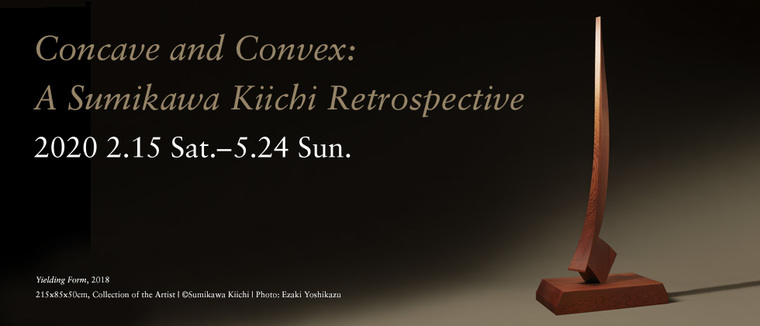
Current Exhibition to be closed (Updated May 1, 2020)
In view of the evolving COVID-19 (Coronavirus Disease 2019) situation, the Yokohama Museum of Art is temporarily closed until further notice. We regret to inform you that the current exhibition, “Sumikawa Kiichi: a Retrospective” will close without reopening before their closing date of May 24.
We thank all of our visitors for their understanding and cooperation.
Overview
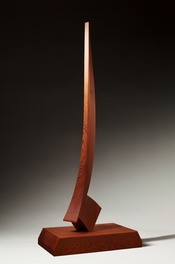
"Yielding Form,” 2018
Cedar, 215×85×50cm
Collection of the artist
©Sumikawa Kiichi
Photo: Ezaki Yoshikazu
Enrolling in Tokyo University of the Arts with the aim of becoming a sculptor, Sumikawa thoroughly absorbed the foundations of figurative expression, with a special emphasis on clay sculpture. After completing a major in sculpture, Sumikawa began teaching at the school while producing a host of his own sculptural works. While displaying profound insight into natural materials such as wood and stone, Sumikawa developed "Yielding Forms,” a series of abstract sculptures that resonated deeply with characteristically Japanese forms of beauty. This theme, which Sumikawa continues to pursue, has become his lifework.
At the same time, Sumikawa has energetically devoted himself to works designed for public spaces. As design director of projects such as the Kazenotou (Tower of Wind, located on Kawasaki, an artificial island in the middle of the Tokyo Bay Expressway), and TOKYO SKYTREE®, he has also received acclaim for a wide range of large urban structures. In Yokohama, Sumikawa has also overseen outdoor sculptures and numerous public art works. In 2013, he received the Yokohama Culture Award. Sumikawa has made cultural contributions to the city, his hometown in Shimane Prefecture, and a host of other places throughout Japan.
This exhibition will serve as the definitive introduction to Sumikawa’s career, which started with figurative sculptures, gradually shifted to cutting-edge abstract sculptures, and eventually expanded to include massive outdoor sculptures and collaborations with architects and others.
Sections
Prologue: Kintaikyo Bridge as a Starting Point
I. Foundation: Mastering Figuration
II. Depth: Confronting Materials
III. Expanse: Utilizing Public Spaces
IV. Craft: Concave and Convex
List of Works [245KB]
Japan's wooden structures such as Horyuji Temple have survived over one thousand years of history. To construct them, master carpenters survey forests and use southern-facing trees for the southern facades and northern-facing trees for the northern facades.
Trees are filled with life.
I open my heart to the voices of the trees while carving out "yielding forms.”
Sumikawa Kiichi
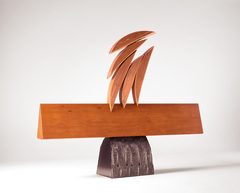
"A Cluster of Trees,” 1992
Teak, pagoda, black granite
196×240×42cm
Shimane Art Museum
©Sumikawa Kiichi
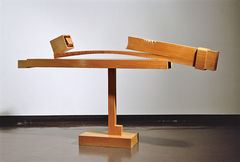
"Yielding Form 1,” 1978
Zelkova, 135×260×45cm
Museum of Contemporary Art Tokyo
©Sumikawa Kiichi
Photo: Murai Osamu
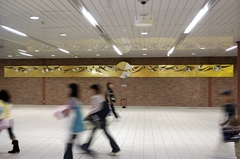
"Gold and Silver Waves,” 2004
Stainless steel, gold leaf, Bashamichi Station, Minatomirai Line (Naka-ku, Yokohama)
©Sumikawa Kiichi
Photo: Ezaki Yoshikazu
*Currently, under conservation.
Highlights
- First Major Retrospective at a Public Museum in the Tokyo Metropolitan Area Devoted to This Pioneer in Postwar Japanese Abstract Sculpture
A pioneer in postwar abstract sculpture, Sumikawa Kiichi has produced a varied body of work, including large-scale public projects. For well over 60 years, his urge to create has continued unabated.
This exhibition, the first large retrospective to be held at a public museum in the Tokyo metropolitan area, will shed light on the origins, developments, and achievements of Sumikawa’s practice. After studying the basics of sculpture with Hirakushi Denchu, a master of wood sculpture, and Kikuchi Kazuo, a leading figure in clay sculpture, Sumikawa concentrated on figurative expression. In time, he shifted his attention to "Yielding Forms,” a series of abstract sculptures that resonates deeply with Japanese traditional beauty, which the artist pursued through the use of intellectual concepts.
- Concave and Convex Forms Rooted in Beauty
Sumikawa has frequently spoken of his youthful attraction to the famous Kintaikyo Bridge, located in Iwakuni, Yamaguchi Prefecture, where he spent his adolescence, as the inspiration for his artistic career. The complex structural beauty and the simple concave and convex forms of the wooden bridge, which managed to escape the ravages of war, dwell within Sumikawa’s heart as a source of sympathetic beauty. Based on his explorations of figurative expression as a university student, Sumikawa set his sights on the natural material of wood. In the process, he discovered the essential forms and beauty of concavity and convexity in wood. The "Yielding Forms” series, Sumikawa’s ongoing lifework, perfectly expresses the refined and simple beauty of his practice. The term "concave” refers to the lines and surfaces that curve gently downward, while "convex” refers to the lines and surfaces that curve gently upward. Sumikawa’s work is firmly rooted in a variety of concave and convex forms that are found in Japanese landscapes and traditional artistic forms. Among the examples he cites are "the gentle arch of an ear of rice with its head bowed, the graceful curves of five-storied pagodas and other historic structures, the extremely tense warp of a sword, and the noble bend that stretches from the sky to the foot of the sacred peak of Mt. Fuji.” - Massive Works for Public Spaces
In the 1980s, Sumikawa began making outdoor sculptures for sites throughout Japan. Sumikawa’s exploration of this medium, which is inseparable from the surrounding environment and landscape, gradually led to an interest in creating works for public spaces, including collaborations with architects and others. He also endeavored to create large urban structures. At present, Sumikawa’s outdoor sculptures and environmental works number over 120. They can be found in 28 of Japan’s 47 prefectures, stretching from Hokkaido in the north to Kagoshima in the south. In some cases, these massive structures, characterizing Sumikawa’s recent artistic output, confront nature, while in others, they take advantage of the spatial possibilities and nestle into the surrounding environment.
Biography
Photo: Utsumi Toshiharu
A leading figure in postwar sculpture and public art, Sumikawa was born in Muikaichi-cho (now Yoshika-cho), Kanoashi-gun, Shimane Prefecture. He first set his sights on becoming an artist while attending Iwakuni Technical High School in Yamaguchi Prefecture. Sumikawa studied with Hirakushi Denchu and Kikuchi Kazuo in the sculpture department at Tokyo University of the Arts, and after first switching from figurative to abstract expression, he began exploring the new artistic realm of outdoor sculpture and forged into the field of public spaces.
Sumikawa embarked on an ongoing series called "Yielding Forms” in the late ’70s. Engaging in a dialogue with wood, these works, based on Japanese traditional culture and aesthetics, enabled Sumikawa to reach a new peak in his practice. He served as president of Tokyo University of the Arts from 1995 to 2001, and in addition to a variety of achievements as an educator, Sumikawa contributed to a wide range of public projects and government-sponsored cultural undertakings. He is a designated Person of Cultural Merits, and has received countless honors, including the Medal with Purple Ribbon in 1998 and Medal with Dark Blue Ribbon in 1999.
Outline
| Dates | February 15 (Sat.)- May 24 (Sun.), 2020 [Current Exhibition to be closed (Updated May 1, 2020) ] |
|---|---|
| Open Hours | 10:00-18:00
*Open until 20:00 on Fridays and Saturdays in May. *Admission until 30 minutes before closing. |
| Closed | Thursdays |
| Organized by | Yokohama Museum of Art (Yokohama Arts Foundation), Nikkei Inc, Kanagawa Shimbun, Television Kanagawa Inc. |
| In Cooperation with | Minatomirai Line, Yokohama Cable Vision Inc., Yokohama FM Broadcasting Co., Ltd., Metropolitan Expressway Co., Ltd. |
Ticket
| Adults | 1,500(¥1,300/1,400) |
|---|---|
| University students
High school students | 900 (700/800) |
| Junior high school students | 600 (400/500) |
| Children under 12 | Free |
| Seniors (65 and older) | 1,400
*ID required. Only available at ticket counter in the museum. |
| Advance Pair Tickets | 2,000
*A pair of tickets for two people. *On sale from October 12 (Sat.) until November 22 (Fri.), 2019 |
*(/)=Advance / Group of 20 or more.
*For a group of 20 or more, reservation is required in advance.
*Advance tickets are available from November 23(Sat.), 2019 until February 14(Fri.), 2020 at the Museum Shop and through Seven-Eleven ticket or eplus ticket.
*Free admission for high school students and younger with valid IDs on Saturdays.
*Free Admission on March 28(Sat.) [Cancelled]
*Visitors with disability and one person accompanying them are admitted free of charge. (Please present certificate at the entrance.)
*The ticket also gives admission to the Exhibition of the Museum Collection for the same day.









